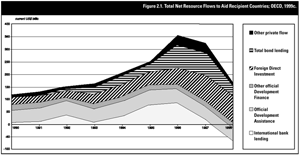2.2.1 International Financial Flows
Several types of international financial flows support technology transfer
(WBCSD, 1998). In practice, the transfer of a particular technology may involve
several of them operating simultaneously or in a coordinated sequence, particularly
for large, costly projects. Among the types of financial flows are:
Official Development Assistance (ODA) and Official Aid (OA). These include
grants and interest free or subsidised loans to developing countries (ODA) and
countries with economies in transition (OA), primarily from member countries
of the Organisation for Economic Co-operation and Development (OECD). ODA/OA
includes both bilateral aid and that provided by governments indirectly through
multilateral organisations.
|

|
| Figure 2.1: Total Net Resource Flows to Aid Recipient
Countries; OECD, 1999c. |
Loans at market rates. These include loans from international institutions,
including the multilateral development banks (MDBs), and commercial banks. As
noted above, some of the grant portions of ODA and OA are also channelled through
MDBs to subsidise their loan interest rates, blurring somewhat the lines between
these categories.
Foreign Direct Investment (FDI) involves direct investment in physical
plant and equipment in one country by business interests from a foreign country.
Commercial sales refer to the sale (and corresponding purchase), on
commercial terms, of equipment and knowledge.
Foreign Portfolio Equity Investment (FPEI) and Venture Capital. These
involve purchase of stock or shares of foreign companies through investment
funds or directly. Venture capital is characterised by being longer term and
higher risk, with a greater degree of management control exerted by the investor.
Other financial flows, include Export Credit Agencies and activities
supported by non-governmental organisations active in technology transfer efforts,
educational and training efforts not captured in the other indicators, and related
transfers.
None of these indicators of investment flows provides a direct measure of technology
transfer, nor, as noted above, do they have a unique relationship with governments,
the private sector, or communities, but all capture levels of technology transfer
to some extent. Many also have the virtue that they have been measured for some
years, allowing an analysis of their changes over time. Trends in each indicator,
as well as its strengths and weaknesses as an approximate measure for technology
transfer, are discussed in the following section; Table
2.1 shows the relationship between the three broad categories of technology
transfer pathway and various types of international financial flows, while Figure
2.1 shows how magnitudes of some of these have changed in recent years.
| Table 2.1 The International Financing
of Technology Transfer |
Technology
Transfer Pathway |
RELATIVE IMPORTANCE OF TYPE OF FINANCIAL FLOW TO TECHNOLOGY
TRANSFER PATHWAY |
| OFFICIAL DEVELOPMENT ASSISTANCE |
LOANS |
COMMERCIAL SALES |
FOREIGN DIRECTt INVESTMENT |
FOREIGN PORTFOLIO EQUITY INVESTMENT |
NGO AND OTHER FLOWS |
| Government |
+++
|
++
|
+
|
+
|
+
|
+
|
| Private Sector |
-
|
+++
|
+++
|
+++
|
++
|
-
|
| Community |
++
|
-
|
-
|
-
|
+
|
+++
|
KEY: +++PRIMARY COMPONENT OF PATHWAY ++SECONDARY COMPONENT OF PATHWAY +MINOR
COMPONENT OF PATHWAY
|